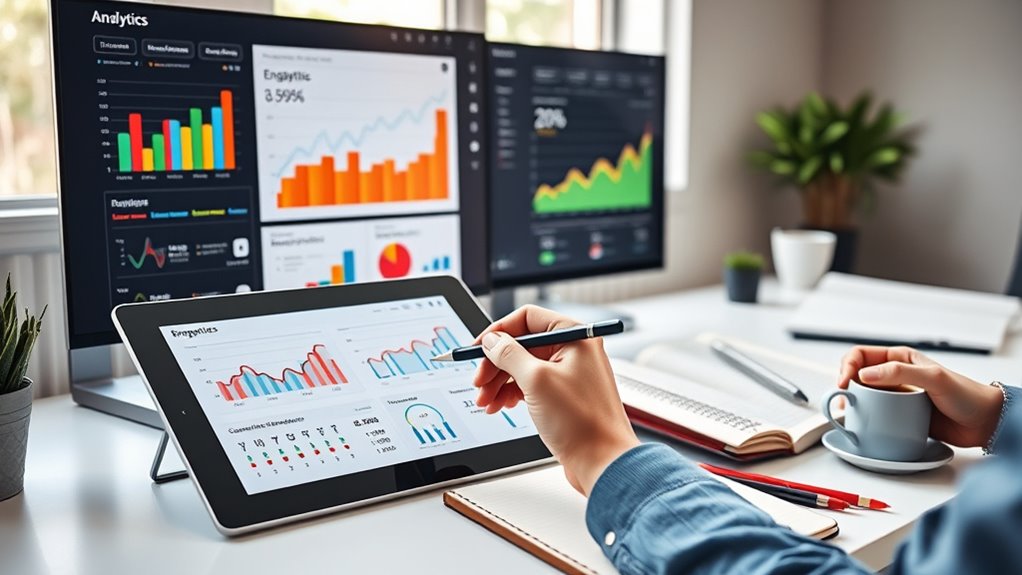Relying solely on pageviews doesn’t give you the full picture of your content’s success. To truly measure effectiveness, you need to look at engagement metrics like time spent, comments, shares, and bounce rates, which show how your audience interacts. Conversions, such as signups or purchases, reveal whether your content drives actions. Gathering audience feedback adds valuable insights. Exploring these metrics will help you understand what works and how to improve your strategy further.
Key Takeaways
- Engagement metrics like comments, shares, and time on page reveal audience interaction beyond mere traffic numbers.
- Conversion rates track how well content drives specific actions such as signups, downloads, or purchases.
- Bounce rates and dwell time indicate content relevance and user interest levels.
- Combining quantitative data with qualitative audience feedback provides deeper insights into content impact.
- Analyzing both engagement and conversions helps refine strategies to enhance content effectiveness.

How do you know if your content truly resonates with your audience? Relying solely on pageviews doesn’t give you the full picture. To gauge genuine impact, you need to look beyond basic metrics and focus on audience engagement and conversion metrics. These indicators reveal whether your content is inspiring interaction and driving meaningful actions.
Audience engagement is a pivotal metric because it shows how your audience interacts with your content. Are they commenting, sharing, or spending time reading? High engagement signals that your content hits the right note, encouraging viewers to connect with what you’ve created. It’s not just about attracting visitors; it’s about fostering a relationship. For example, if a blog post garners lots of comments or shares, it indicates that your message resonates deeply, prompting your audience to participate actively. Tracking metrics like time on page, bounce rates, and social shares helps you understand whether your content holds their interest or if they quickly move on. If engagement drops off quickly, it’s a sign to refine your messaging, visuals, or calls to action.
High engagement indicates your content resonates, encouraging interaction and fostering meaningful audience relationships.
Conversion metrics are equally essential because they measure if your content leads to tangible results. These results could be newsletter signups, product purchases, downloads, or any other goal you set. If your content aims to generate leads, then the number of conversions tells you whether it’s successful. Even if your page gets a lot of traffic, without conversions, it’s not enough. You want to see your audience taking specific actions that align with your overall objectives. Monitoring conversion rates helps you identify which pieces of content are most effective in moving prospects through your sales funnel. It also allows you to optimize future content based on what’s proven to work.
Understanding these metrics isn’t just about collecting data; it’s about interpreting what it means for your strategy. If you notice high engagement but low conversions, it might mean your content sparks interest but doesn’t clearly lead to a call to action. Conversely, high conversion rates with low engagement could suggest you’re reaching the right audience but not fostering ongoing interactions. By analyzing both audience engagement and conversion metrics, you gain a holistic view of your content’s effectiveness. This insight enables you to tweak your approach—whether that’s enhancing the content itself, adjusting your distribution channels, or refining your calls to action—so that your content truly connects and converts.
Additionally, measuring audience feedback can provide qualitative insights that complement quantitative data, helping you understand the motivations behind user actions.
In the end, measuring content effectiveness requires more than just counting pageviews. It’s about understanding how your audience interacts with and responds to your content, then using that knowledge to improve your strategy. Focus on engagement and conversions, and you’ll see a clearer picture of what’s working—and what needs to change—to achieve your goals.
Frequently Asked Questions
How Do I Choose the Right Metrics for Different Content Types?
You choose the right metrics by considering your audience segmentation and content personalization goals. For engaging a specific group, track metrics like time on page and conversion rates. If you’re tailoring content, monitor engagement signals such as shares and comments to gauge resonance. Focus on metrics that reveal how well your content meets audience needs, helping you refine your strategy and improve relevance across different content types.
What Tools Are Best for Tracking Advanced Content Metrics?
Tracking advanced content metrics is like using a sophisticated compass. Tools like Google Analytics, Mixpanel, and Hotjar shine when it comes to measuring content personalization and audience segmentation. They offer detailed insights into user behavior, engagement, and conversion patterns. These platforms help you go beyond basic metrics, enabling you to fine-tune your strategies for different audience segments and improve overall content effectiveness effectively.
How Can I Interpret Negative Engagement Signals?
You should look at negative feedback and bounce rate to interpret negative engagement signals. If visitors leave comments criticizing your content or express dissatisfaction, that’s a clear sign it’s not resonating. A high bounce rate indicates visitors aren’t finding what they need or engaging further. Use these signals to identify areas for improvement, such as refining your content’s relevance or clarity, and then test adjustments to see if engagement improves.
How Often Should I Review and Update My Content Metrics?
You should review and update your content metrics at least quarterly—think of it as a crucial pulse check! This frequency ensures you’re capturing the latest audience feedback and spotting trends before they fade. A regular content refresh keeps your strategies sharp and relevant, preventing your content from becoming outdated. By consistently evaluating your metrics, you can fine-tune your approach, stay ahead of competitors, and maximize engagement effectively.
What Are Common Pitfalls in Measuring Content Effectiveness?
You might overlook important pitfalls like relying solely on pageviews, which can be misleading. Instead, focus on click-through rates to gauge engagement and bounce analysis to see if visitors find your content valuable. Avoid ignoring these metrics, as they provide deeper insights into your content’s true effectiveness. Regularly analyzing these factors helps you refine your strategy and create content that genuinely resonates with your audience.
Conclusion
Remember, metrics are just the map, not the destination. While pageviews can show popularity, true content effectiveness lies in engagement, conversions, and loyalty. Don’t let the allure of numbers blind you—look deeper, ask better questions, and measure what truly matters. Like a lighthouse guiding ships through darkness, meaningful metrics illuminate your path to genuine connection and success. Keep evolving your approach, and your content will always find its way.








